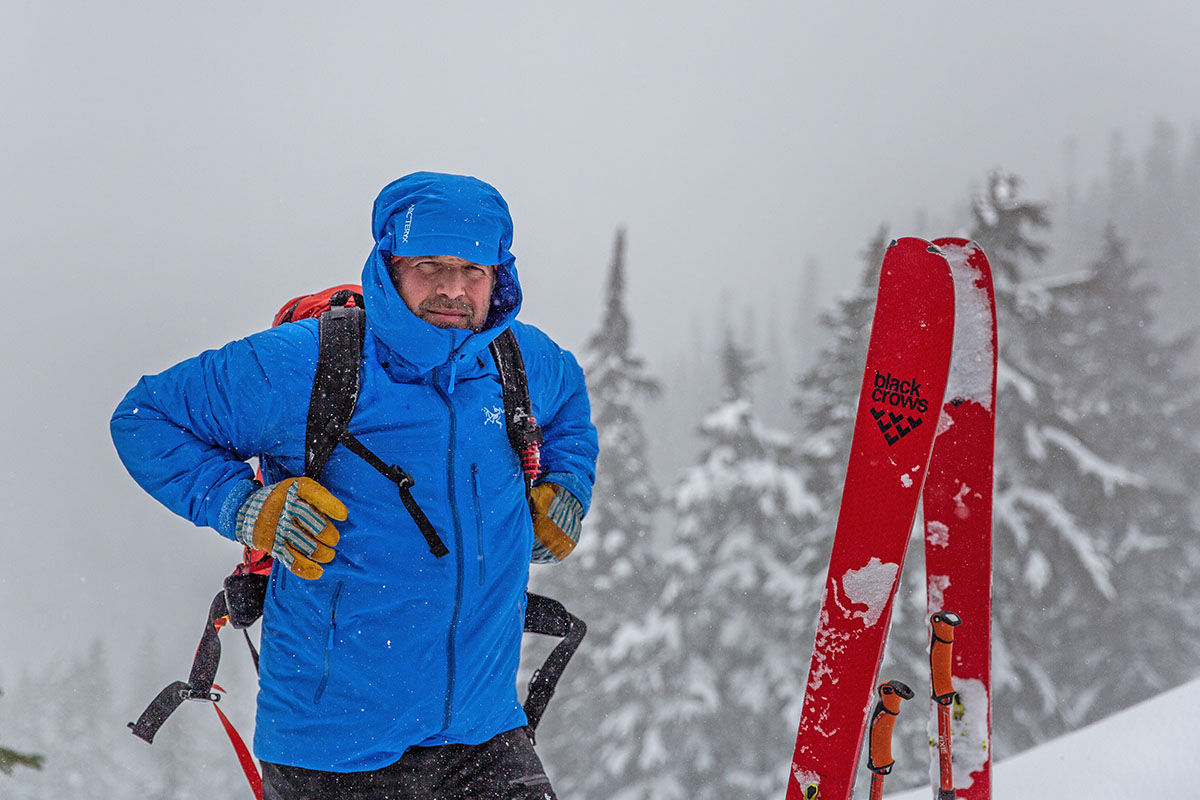
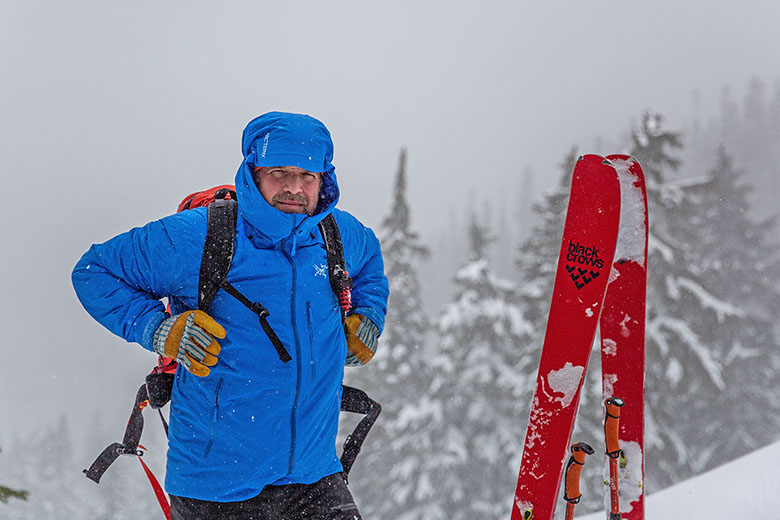
Price: $750
Insulation: Coreloft Continuous (90g & 100g)
Weight: 1 lb. 9.3 oz. (men’s large)
What we like: Great combination of protection and warmth for harsh mountain conditions.
What we don’t: It’s a pretty specialized piece at a steep price point.
See the Men's Beta Insulated Jacket See the Women's Beta Insulated Jacket
Arc’teryx’s Beta collection is a longtime favorite, lauded for its reliable protection and top-notch build quality. A relatively recent addition to the line, the Beta Insulated Jacket retains a lot of what we love about the uninsulated models, including trustworthy protection in the form of 2-layer Gore-Tex, and adds a healthy dose of synthetic fill. We tested both the men’s and women’s versions last winter (this review primarily covers the men’s jacket) and came away with high praise. It’s a pretty specialized piece and a steep investment at $750, but for the right conditions—think frigid ski tours, cold alpine belays, and winter camping—it’s a near-ideal pairing. Below we break down our impressions of the Beta Insulated Jacket. To see how it stacks up to the competition, check out our articles on the best winter jackets and best synthetic insulated jackets.
We’ve rarely—if ever—been disappointed by the protection of a waterproof design from Arc’teryx, and the Beta Insulated Jacket is no exception. First and foremost, the 2-layer Gore-Tex shell is highly reliable and did a remarkable job fending off strong winds, snow, and rain during an unseasonably cold Pacific Northwest winter. Arc’teryx also included taped seams for added assurance, as well as a durable water repellent (DWR) finish to help moisture bead up and roll off the exterior rather than soak through. 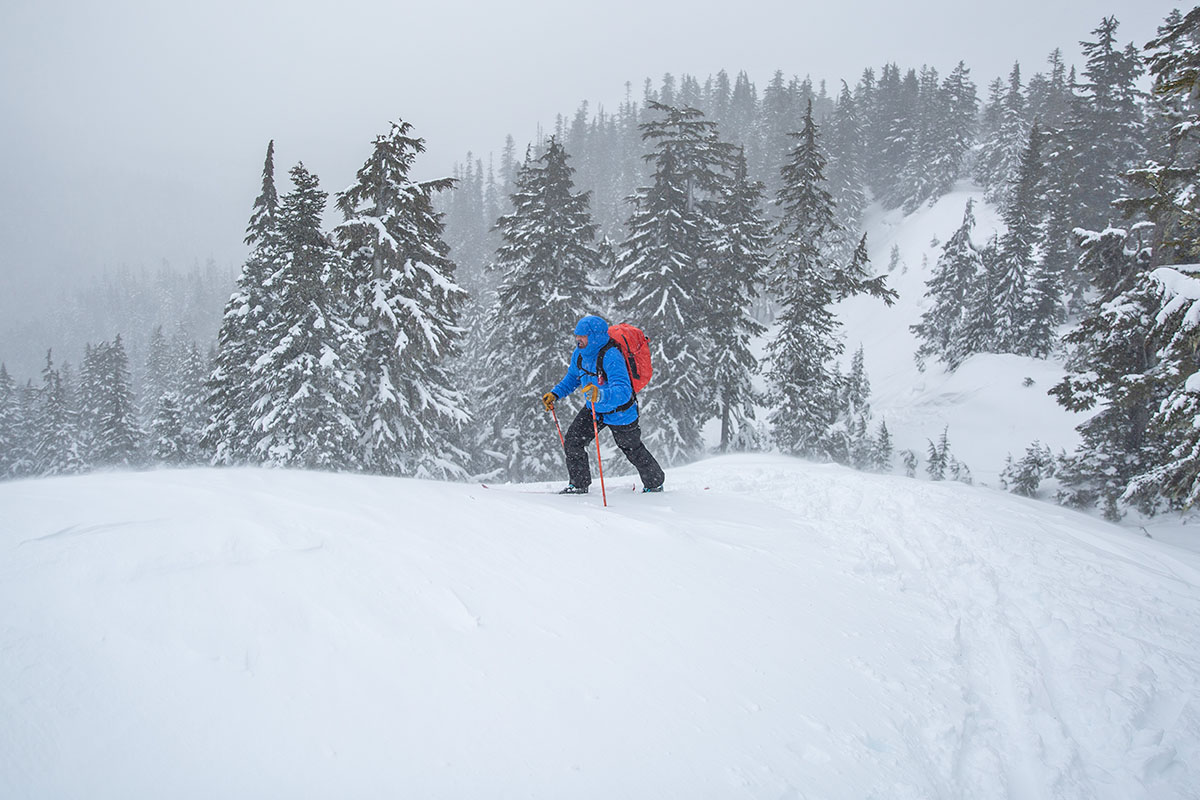
The jacket’s feature set is equally well executed for sealing out the elements, including a helmet-compatible hood that leaves minimal skin exposed when cinched tight, a tall collar that effectively blocks moisture and wind, water-resistant zippers that are trustworthy enough to protect electronics, and Velcro cuff adjustments that work with both undercuff and gauntlet-style gloves. Combined with a fairly long cut (around 32 in. in my men’s large) and dual hem drawcords, the Beta Insulated has shown no signs of weakness throughout testing, even during a big fall in powder.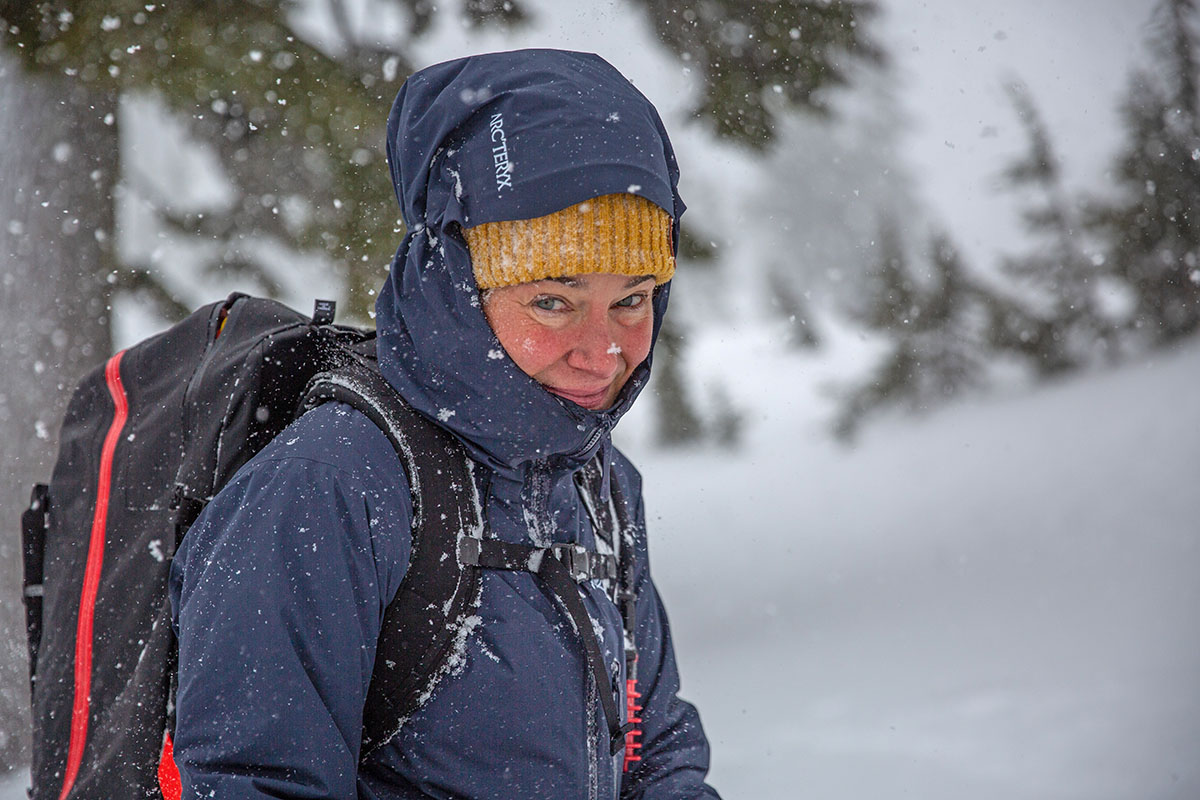
Warmth is where the Beta Insulated Jacket truly shines. For insulation, Arc’teryx opted for a mix of 90- and 100-gram (g) Coreloft Continuous, which lacks the impressive warmth-to-weight ratio and standout compressibility of down fill but retains its loft—and insulating abilities—when it gets wet. This was especially helpful when touring in the jacket: Despite working up a sweat on the way up, I managed to stay perfectly cozy while transitioning and descending. By comparison, I almost certainly would have grown chilly from a damp down layer. The jacket also did an admirable job of keeping me toasty while hanging around camp and during an arctic blast that pummeled my wife and me with harsh sleet and heavy snow (again, down fill wouldn’t have fared as well). Given my experiences thus far, I expect the Beta Insulated to be a great resort companion, too.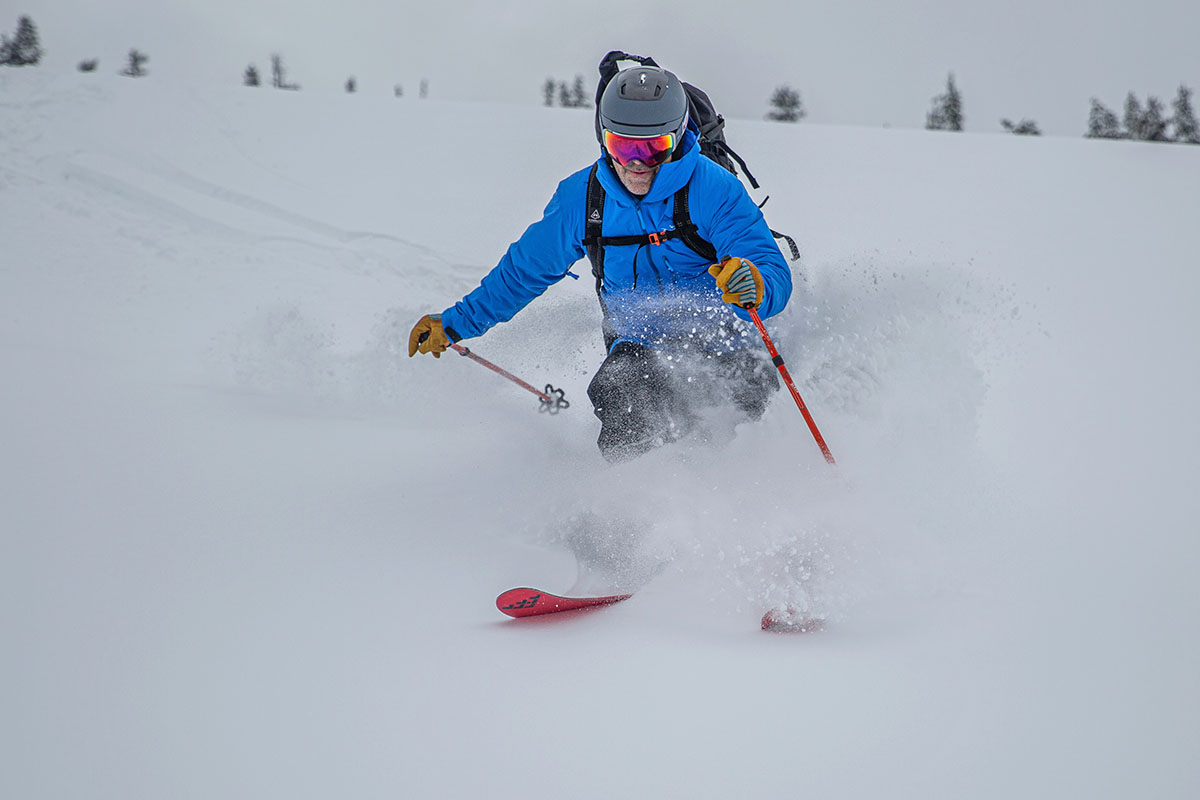
The Arc’teryx Beta Insulated Jacket scores similarly high marks in the comfort department. For starters, the nylon lining is smooth against the skin and does a good job at wicking moisture (although it will soak through eventually if you’re really working up a sweat). Additionally, the Coreloft insulation has a plush and low-profile feel, and the 2-layer Gore-Tex shell is noticeably less stiff, crinkly, and noisy than thicker Gore-Tex Pro designs like the Patagonia PowSlayer or Arc’teryx’s own Alpha SV. Another highlight is mobility: The jacket’s articulated patterning and accommodating fit (more on the latter below) allowed for unrestricted freedom of movement while transitioning and loading gear into our van. All in all, I’ve been impressed by the jacket’s overall comfort and haven’t hesitated to keep it on when hanging around camp after long days out.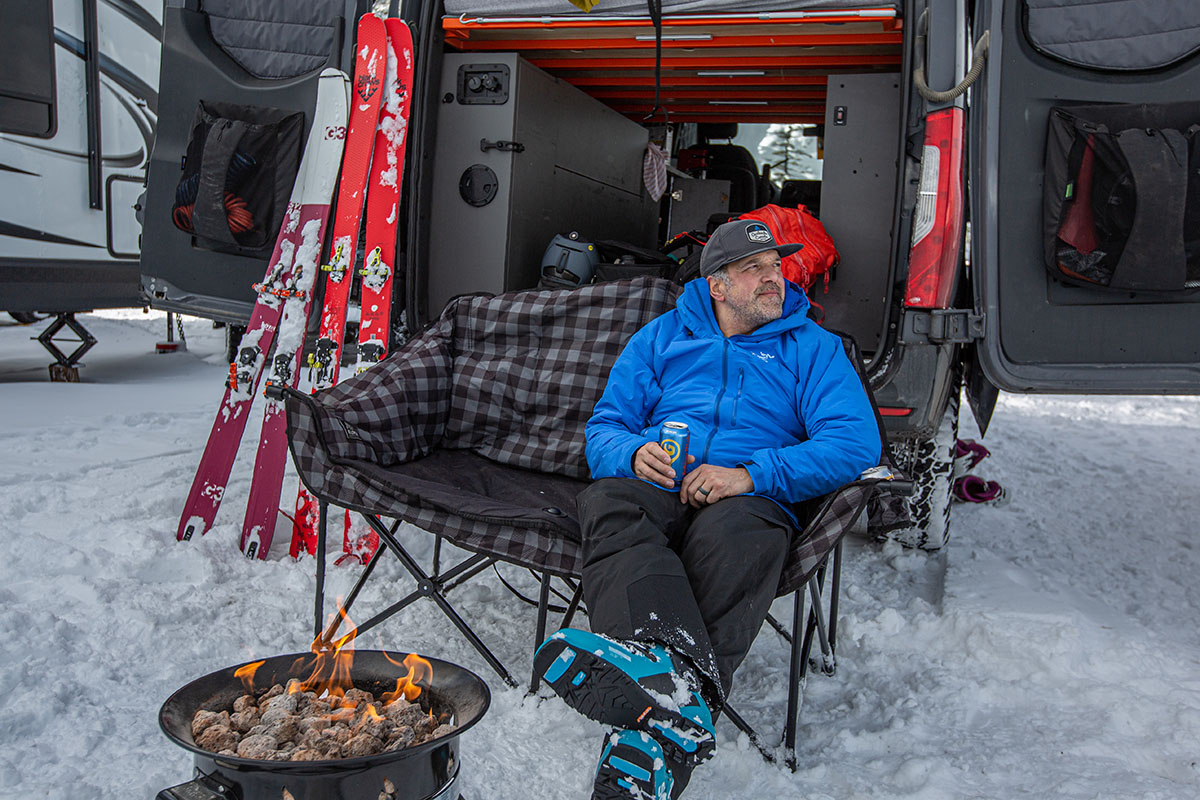
As expected, the Beta Insulated’s 2-layer shell and substantial dose of synthetic fill limit its overall breathability. The good news is that Arc’teryx included generously sized (16-in.) pit zips, which go a long way toward releasing excess heat. I’ve also been able to boost airflow by unzipping the two-way main zip from the bottom, which worked well when I was wearing ski bibs (they kept me protected from the elements even with the zipper partially undone). That said, there’s no getting around the fact that the Beta Insulated is best suited for mild to moderate activity in cold weather—below freezing, by my estimate. In practice, I’ve found it ideal for transitioning and descending in these conditions, and it’s also been workable on short bootpacks, yo-yo laps, and tours in blizzard-like weather. For mild days out, however, I’d leave the Beta Insulated behind and opt for a separate midlayer and shell so that I can tailor warmth as temperatures—including my own body temperature—shift throughout the day.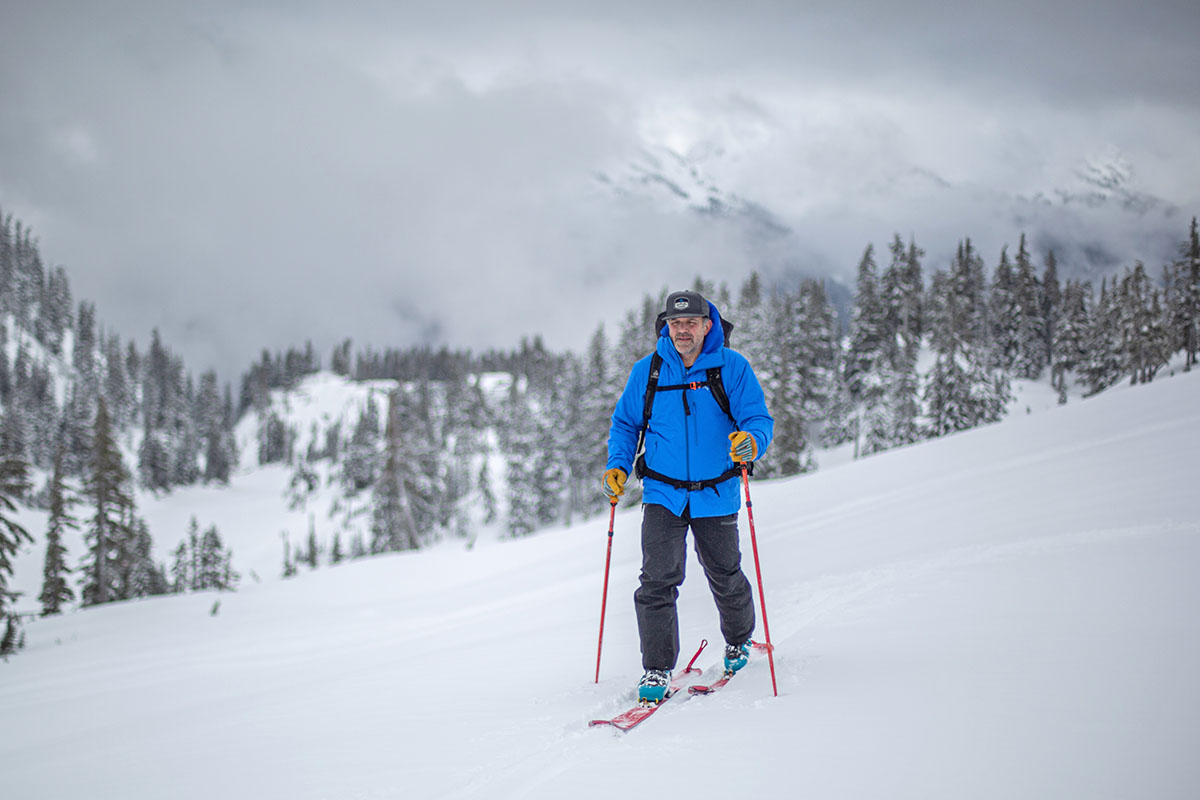
Arc’teryx gear rarely comes cheap, and the Beta Insulated Jacket is no exception at a steep $750. Here, though, the overall build quality lines up well with the price. I was initially a little wary of the 40-denier (D) construction, which is notably thinner than some of my favorite Arc’teryx shells including the Alpha SV hardshell (100D) and Sabre ski jacket (80D). However, I’m happy to report that my concerns were entirely unfounded: The face fabric feels much more robust than the specs would suggest and has performed flawlessly thus far. I should also mention that I haven’t gone easy on the Beta Insulated—I’ve worn it in gnarly weather in the backcountry and frequently crammed it in my pack with sharp equipment like crampons and avalanche gear. Through it all, the exterior has held up remarkably with no signs of abrasion, and all the smaller components are faring equally well. After a thorough round of testing, all signs are positive that the jacket will last a long time.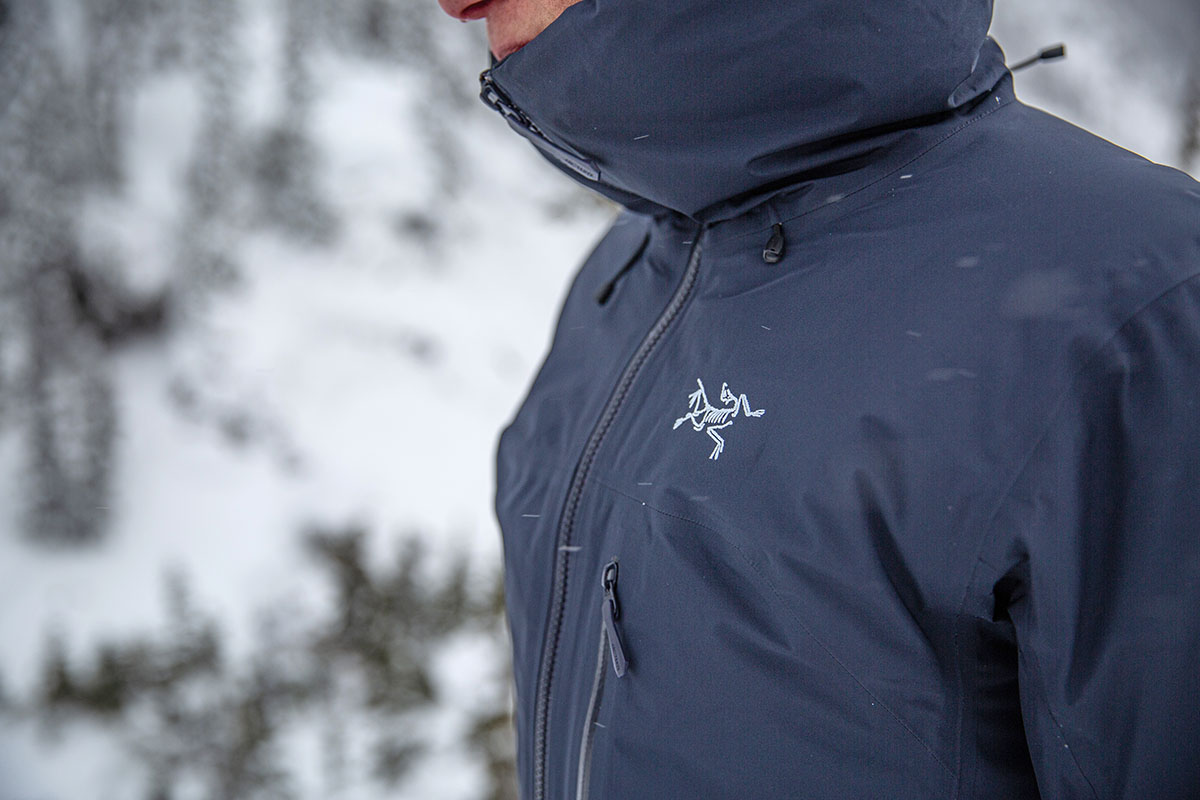
At 1 pound 9.3 ounces in a men’s size large—slightly above its 1-pound-8-ounce listed weight—the Beta Insulated is reasonably light considering its two-in-one (shell plus midlayer) construction. There aren’t many apples-to-apples comparisons given the jacket’s fairly specialized build, but one direct competitor is Patagonia’s Micro Puff Storm, which also features a 2-layer waterproof shell and 90g synthetic fill in a 1-pound-3.8-ounce package. Arc’teryx’s Rush Insulated Jacket, which is purpose-built for ski touring—also checks in at 1 pound 3.8 ounces, although it uses a Gore-Tex Infinium shell that’s windproof but only water-resistant. On the flip side, the down-filled version of the Beta Insulated Jacket checks in heavier at 1 pound 10.8 ounces, but you do get a bump in warmth from the 850-fill down.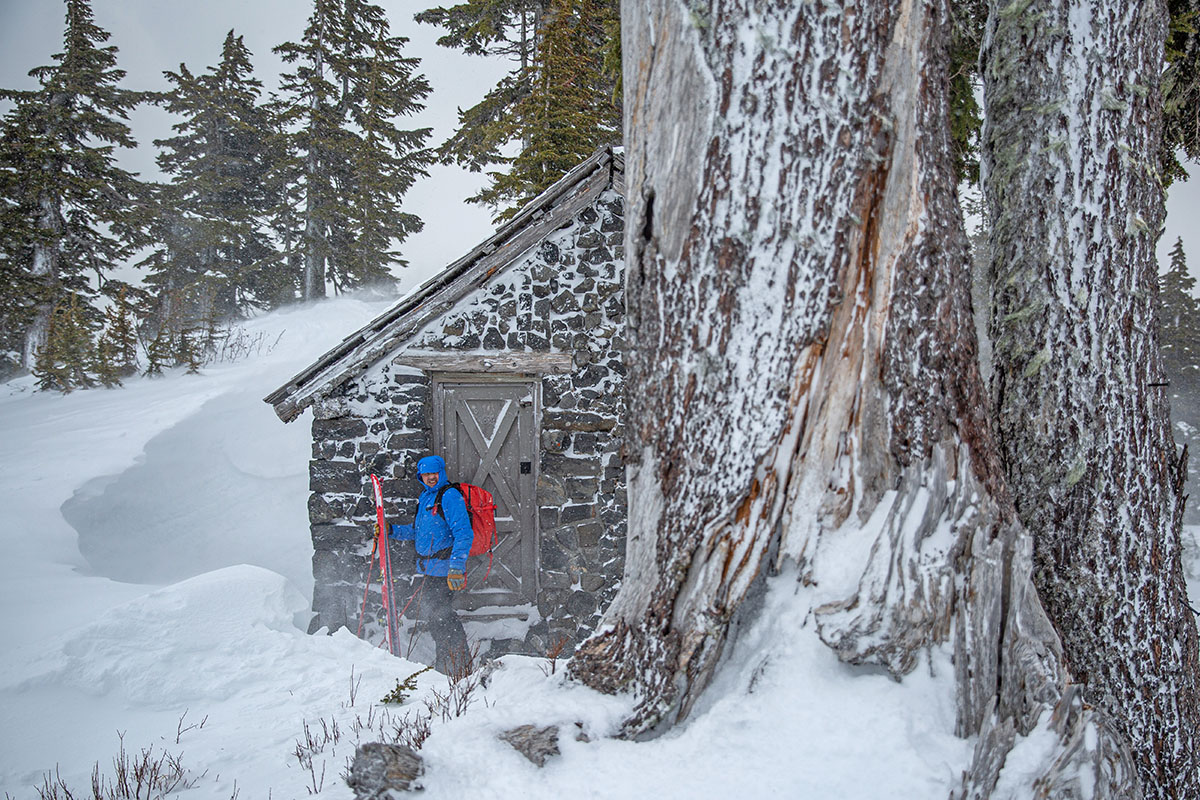
Importantly, the Beta Insulated Jacket never felt overly heavy, and it undercuts most shell-and-midlayer combos by at least a few ounces. For example, my Arc’teryx Alpha SV paired with a lightweight down puffy like the Cerium Jacket—both considered to be very light among the competition—checks in at 1 pound 11.7 ounces total. The Beta Insulated is also impressively packable, stuffing down to about the size of a volleyball in its hood with the drawcord cinched, and the synthetic fill does a good job of returning to its original loft after being compressed.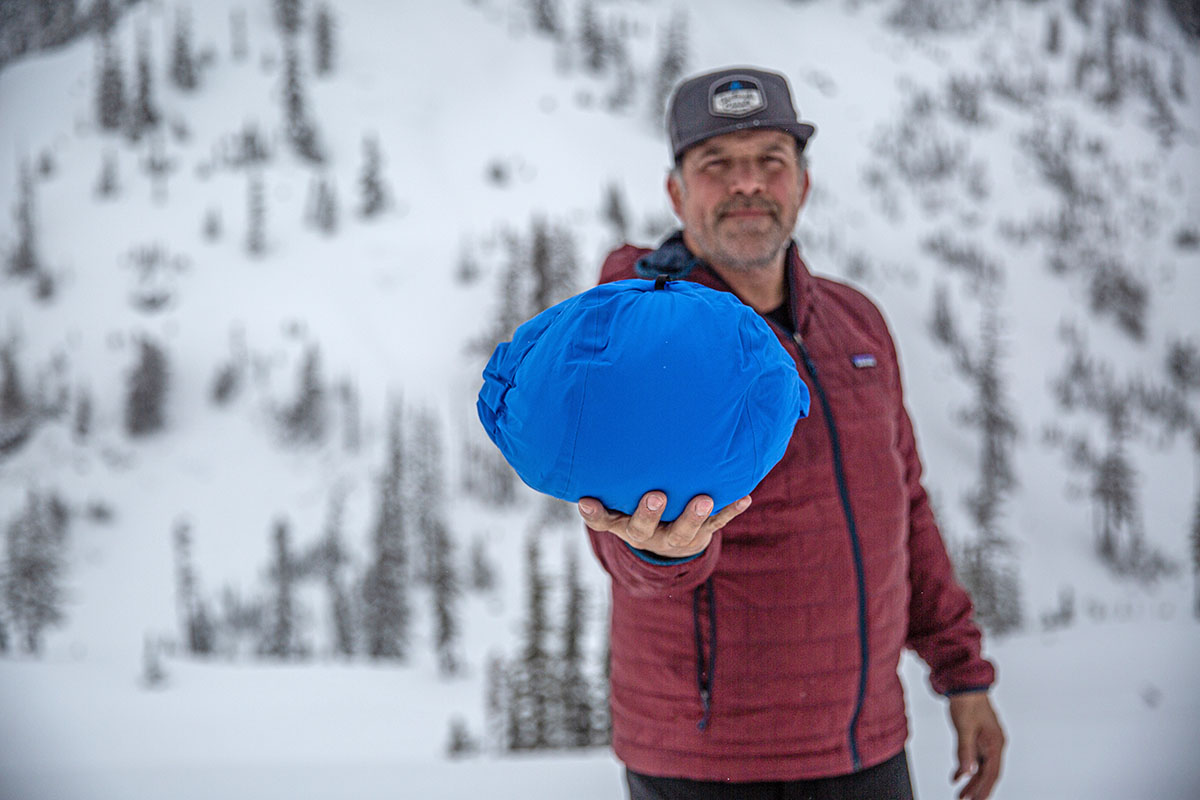
It’s no secret that Arc’teryx’s StormHood design is our favorite on the market, and the Beta Insulated is another successful iteration. For starters, the hood is quick and easy to adjust via four drawcords: two at the back and two at the front below the collar. When cinched tight, the design offers great all-around coverage—only my goggles, nose, and upper lip are left exposed—without impeding peripheral vision or range of movement. It also comfortably fits over a ski or climbing helmet—I often paired it with my Oakley Mod5 MIPS and had no complaints. Finally, the stiff brim has done a great job at keeping precipitation from dripping onto my face and accumulating on my goggles. Taken together, the hood shares the same premium and well-executed fit and finish as the rest of the jacket.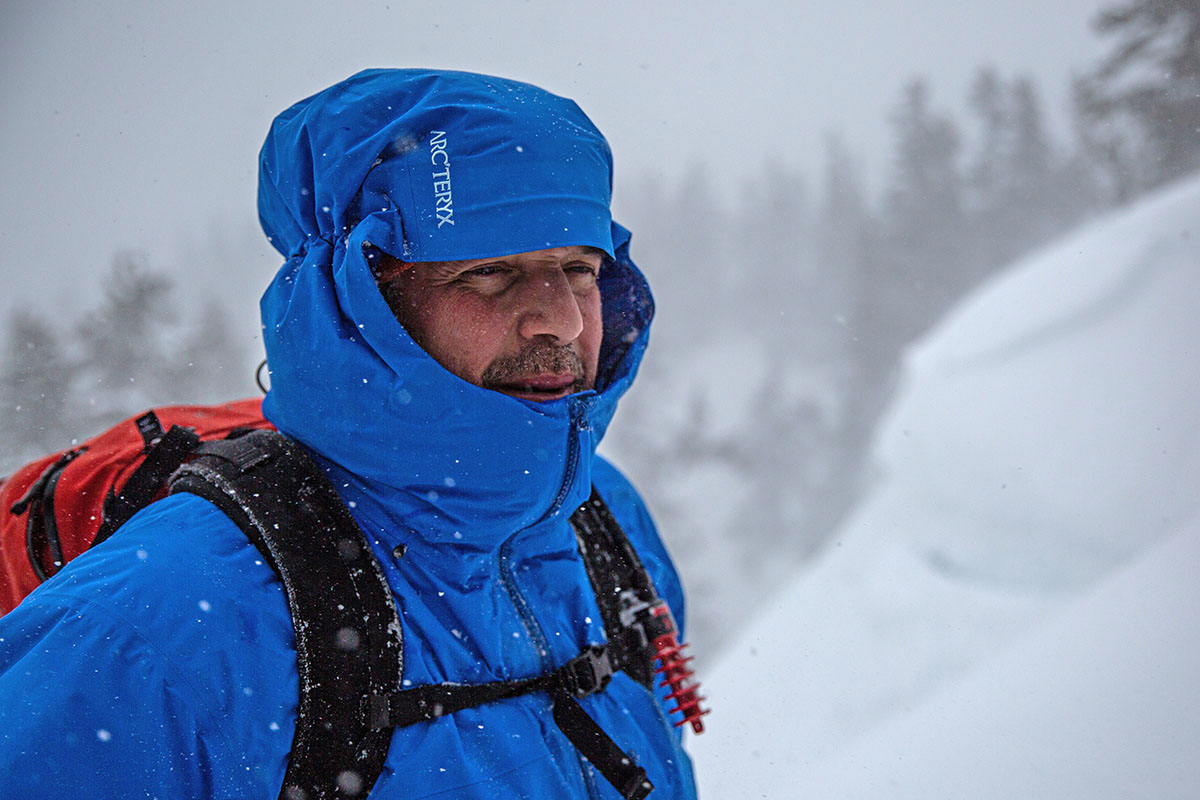
In terms of storage, the Beta Insulated comes nicely equipped with five total pockets. Starting at the outside, you get two fleece-lined hand pockets that are very cozy and big enough to comfortably fit gloved hands or stash a beanie, gloves, or snacks. There’s also a small chest pocket on the left side that works well for items like a Garmin inReach, map, or smartphone. Importantly, all three pockets boast Arc’teryx’s WaterTight zippers, which technically aren’t fully waterproof but have done an admirable job of keeping my valuables safe and dry (I trust them enough that I don’t think twice, even in inclement weather). Moving to the inside, Arc’teryx included a dump pocket on the right that can accommodate goggles or climbing skins, although it’s a fairly snug fit with those items, and I wish Arc’teryx had either made it bigger or included an identical pocket on the opposite side. To round out the layout, there’s an internal zippered pocket on the left that’s ideal for stowing small valuables like a wallet and/or keys.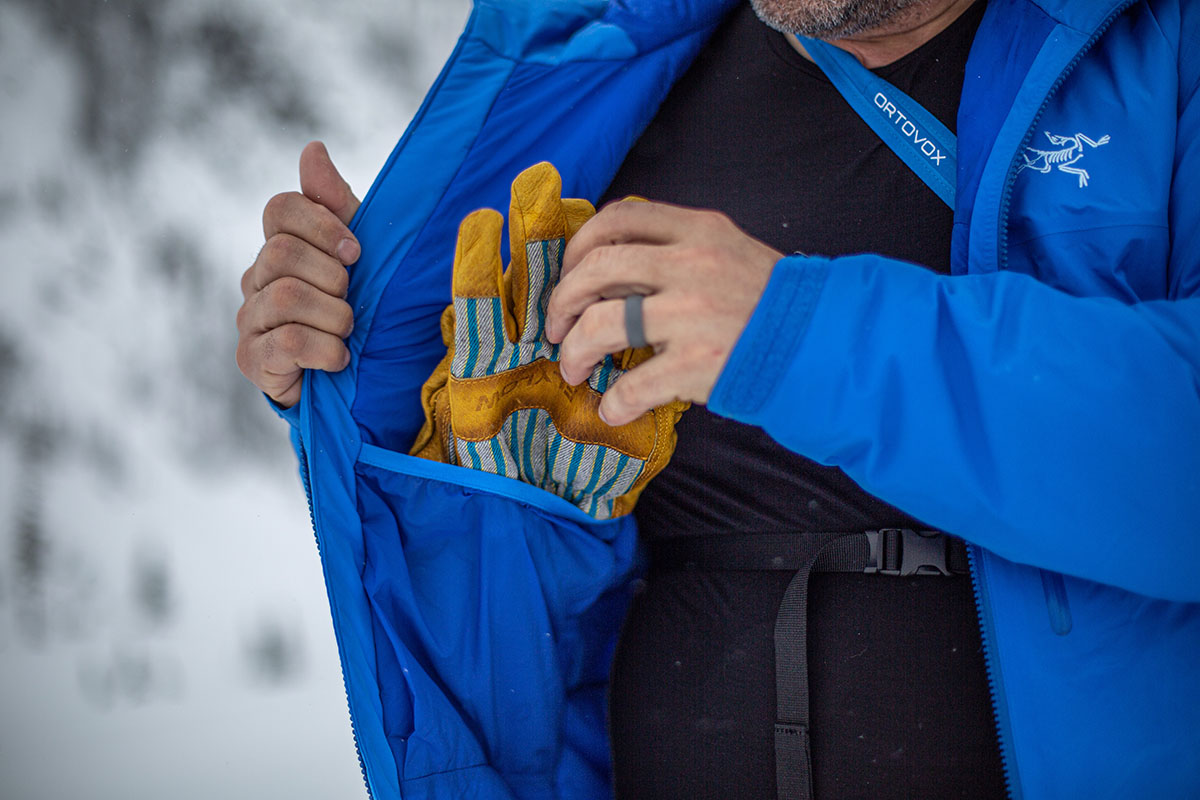
The Beta Insulated Jacket is labeled as a “regular” fit, and my usual men’s large was true to size. My wife also found her standard women’s small to be spot-on. Layering underneath the jacket is a little superfluous given its very warm build, but both of us were able to comfortably add a lightweight down or synthetic jacket when needed (which was seldom). I’m also a huge fan of the two-way main zipper mentioned above, which made it easy to sit down and bend over without the shell bunching up uncomfortably, and the arm and hem lengths are spot-on for my 6’3” frame. Finally, as I discussed in the “Comfort” section above, the Beta Insulated Jacket boasts articulated patterning to maximize range of movement, and I’ve had no issues with mobility throughout testing.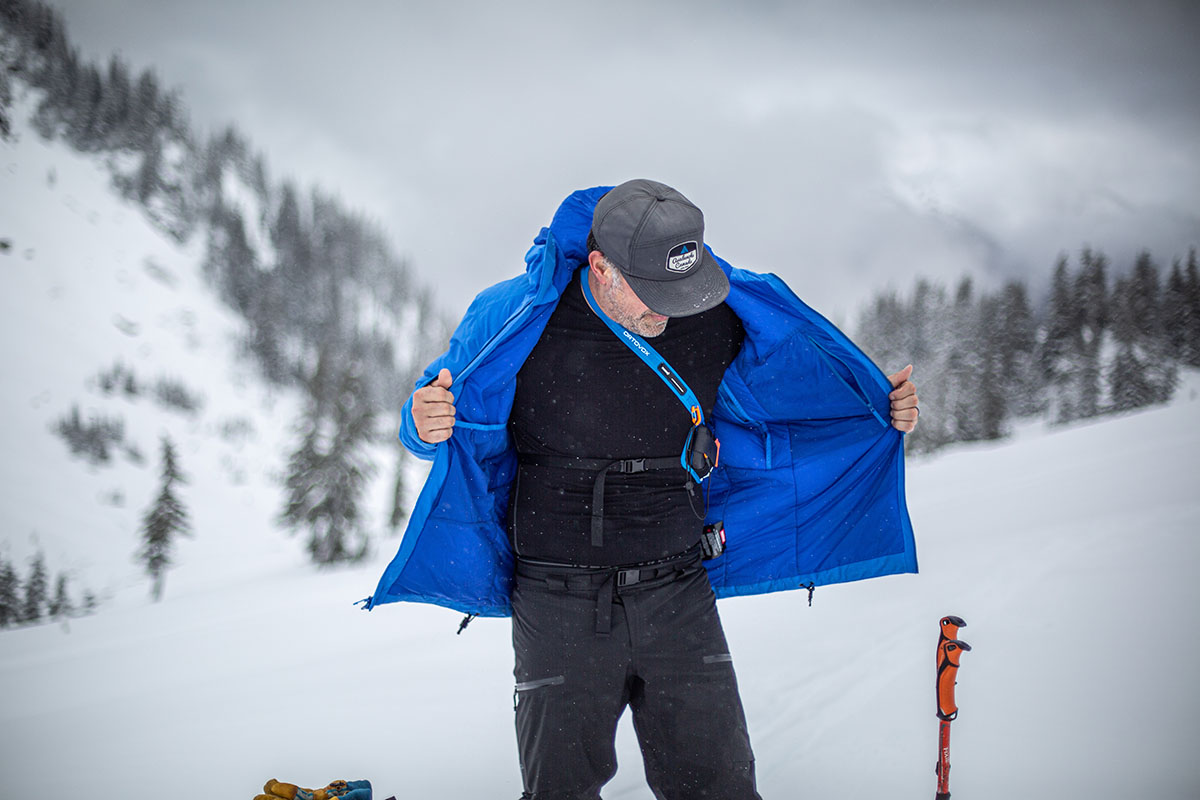
Sustainable production practices are becoming increasingly common among leading outdoor brands, and Arc’teryx is no exception. In this case, the Beta Insulated Jacket’s lining utilizes recycled nylon (although they don’t list the exact percentage), and both the lining and shell are bluesign-approved, which means they’re free from harmful chemicals and have been deemed safe for workers, consumers, and the environment. We’d love to see Arc’teryx tack on a Fair Trade certification and PFC-free DWR finish in a future update, but we nevertheless appreciate the progress they’ve made thus far on the sustainability front.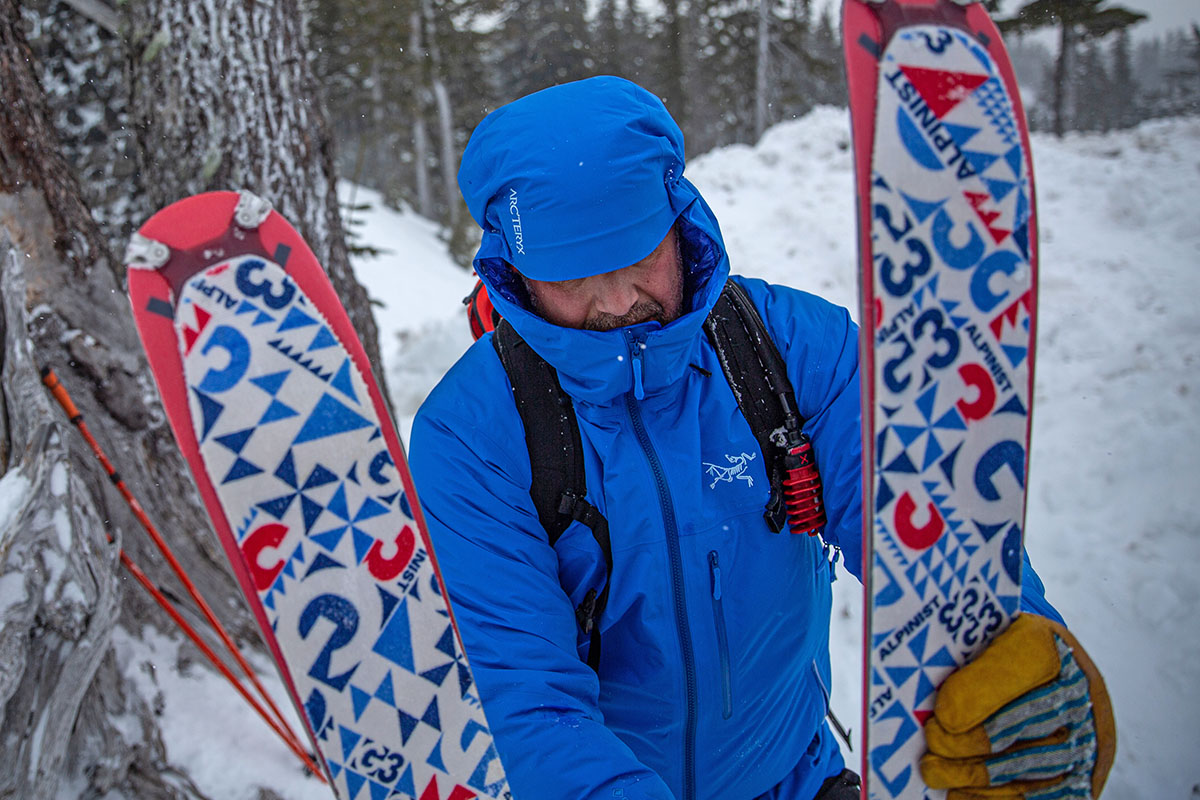
We put the men’s Beta Insulated Jacket through its paces for this review, and Arc’teryx also makes a women’s version for the same price. Comparing the two, the women’s Beta Insulated Jacket checks in a little lighter at 1 pound 5.2 ounces, is sold in different colorways, and uses a mix of 90 and 100g Coreloft but retains an otherwise identical build and feature set. There’s also a longer version for women called the Beta Insulated Coat, which costs $50 less than the standard version, is insulated with 80 and 120g Coreloft, boasts a low-profile (read: non-helmet-compatible) StormHood, and offers coverage down to mid-thigh. Last but not least is the men’s Beta Down Insulated Jacket ($1,000), which is packed primarily with down rather than synthetic fill (it does use Coreloft in moisture-prone areas) and is the warmest—albeit priciest—option in the collection.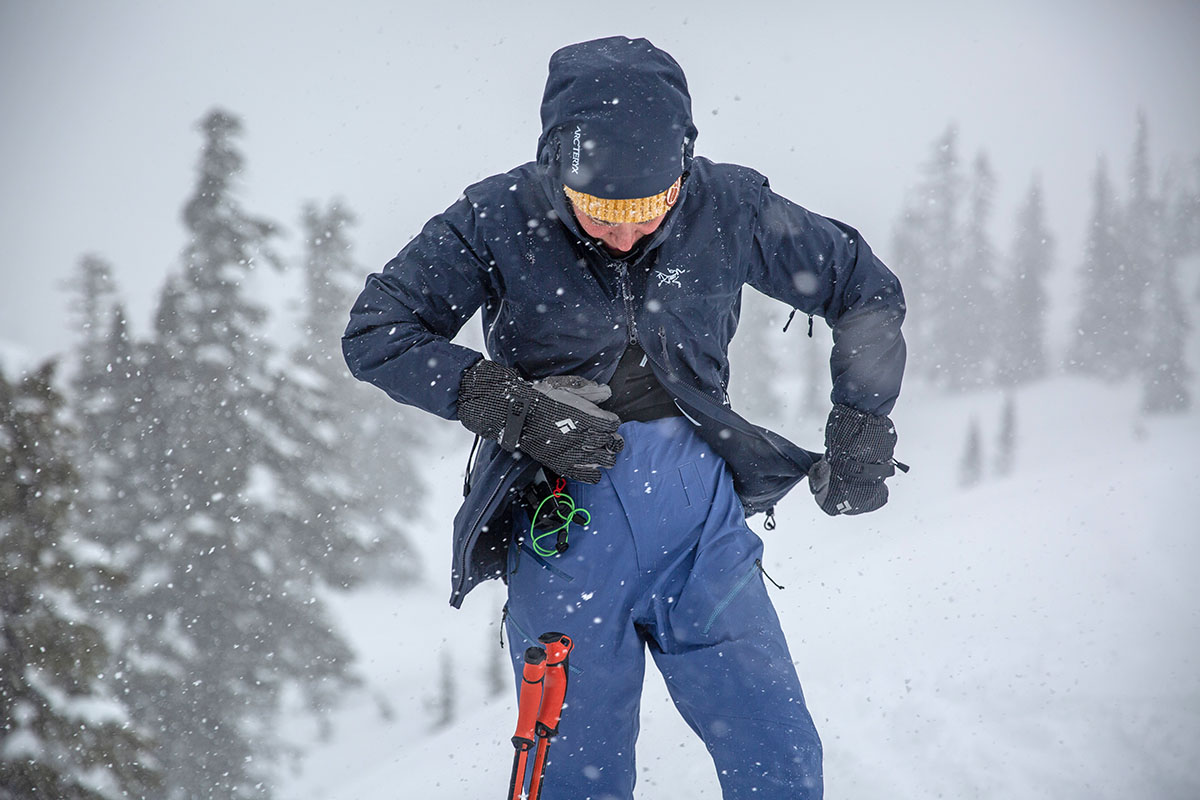
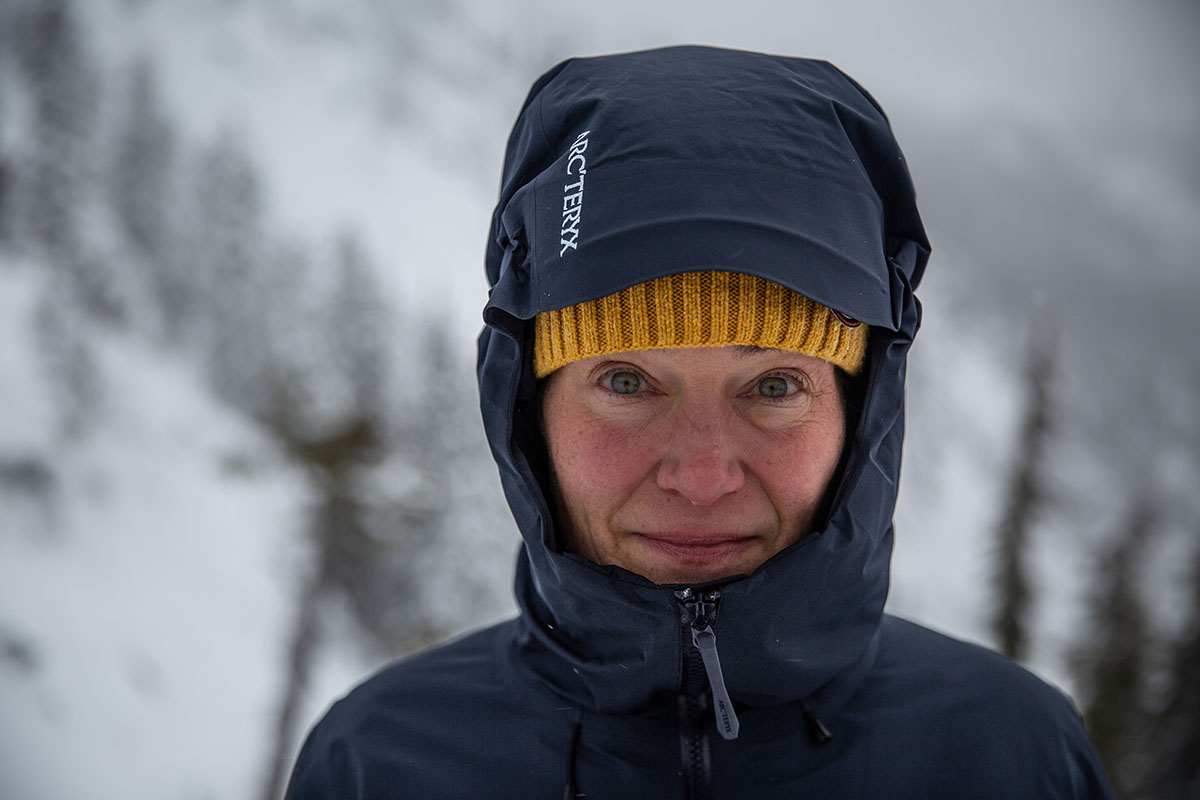
| Jacket | Price | Weight | Waterproof | Insulation | Fabric |
|---|---|---|---|---|---|
| Arc'teryx Beta Insulated | $750 | 1 lb. 8 oz. | 2L Gore-Tex | Coreloft (90 & 100g) | 40D |
| Patagonia Micro Puff Storm | $549 | 1 lb. 3.8 oz. | 2L H2No | PlumaFill (90g) | Unavail. |
| Arc'teryx Sabre Insulated | $850 | 1 lb. 12.7 oz. | 2L Gore-Tex | Coreloft (80g) | 80D |
| Rab Neutrino Pro Jacket | $400 | 1 lb. 4.6 oz. | None | 800-fill down (7.5 oz.) | 20D |
| REI Stormhenge Down | $279 | 1 lb. 15.8 oz. | 2L HydroWall | 850-fill down; synthetic (180 & 80g) | Unavail. |
The Beta Insulated Jacket stands out for its effective combination of protection and warmth for harsh mountain conditions, but it’s far from a great value at $750. For around $200 less, Patagonia’s Micro Puff Storm shares a similar build and overall intentions. Like the Arc’teryx, the Micro Puff Storm features a 2-layer waterproof shell (Patagonia’s in-house H2No) with a healthy dose (90g) of synthetic PlumaFill insulation. You also get a well-thought-out feature set that includes a helmet-compatible hood, four total pockets (including two drop-in pockets inside), and a storm gasket around the hem to seal out wind and snow at the waist. On the flip side, the Arc’teryx tacks on Velcro cuff adjustments, pit zips, multi-point adjustability on the hood, a two-way front zipper, and the aforementioned waterproofing upgrade. It’s up to you whether the additions are worth the sizable price jump, but the Micro Puff is competitively priced for what you get (for more, see our in-depth Micro Puff Storm review).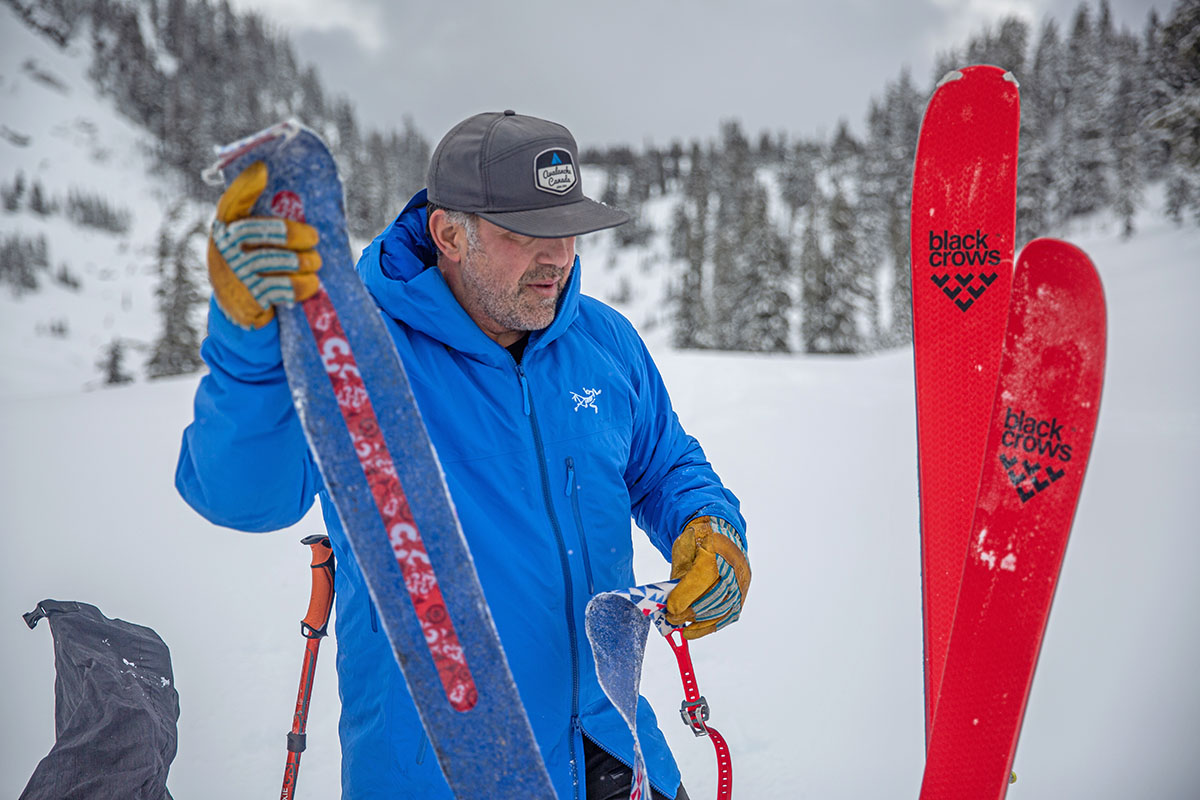
A second intriguing alternative comes from within Arc’teryx’s own lineup: the Sabre Insulated Jacket. A new addition to the well-loved ski line for this season, the Sabre Insulated boasts a similar recipe to the Beta: 2-layer Gore-Tex protection and synthetic Coreloft insulation (80g) for warmth. The feature set also lines up closely, including a helmet-compatible StormHood, pit zips, five total pockets (although the Sabre trades an interior zippered pocket for an external sleeve pocket), and a regular fit that’s accommodating without feeling overly bulky. However, the Sabre is more ski-specific than the all-rounder Beta, with additions like a powder skirt for sealing out snow at the waist, the aforementioned sleeve pocket for a ski pass, and a more robust 80D face fabric that will stand up better to frequent resort use. It’s also heavier by 4.7 ounces, which won’t be a concern for inbounds riders but is a little too hefty for long slogs into the backcountry (especially when you factor in the weight of a midlayer).
As we mentioned, many backcountry-goers prefer to tailor their layering depending on conditions with a separate midlayer and shell. For the best warmth-to-weight ratio, we turn to premium down jackets like Rab’s Neutrino Pro. For a whopping $350 less than the Beta Insulated, the Rab shaves off 3.4 ounces while packing in 7.5 ounces of 800-fill down. It’s hard to make an exact warmth comparison given the Beta’s synthetic fill, but we found both jackets to be well suited for mild to moderate activity in cold (freezing or below) conditions. The Neutrino Pro also retains key technical features like a two-way front zipper, an adjustable and helmet-compatible hood with a stiff brim, water-resistant zippers, and a cinchable hem and cuffs. The Beta Insulated is the more reliable outer layer, but the Rab is no slouch with a highly water-resistant Pertex Quantum Pro shell and hydrophobic coating on the down. If you already own a waterproof shell, the Neutrino Pro is a class-leading design at a great price.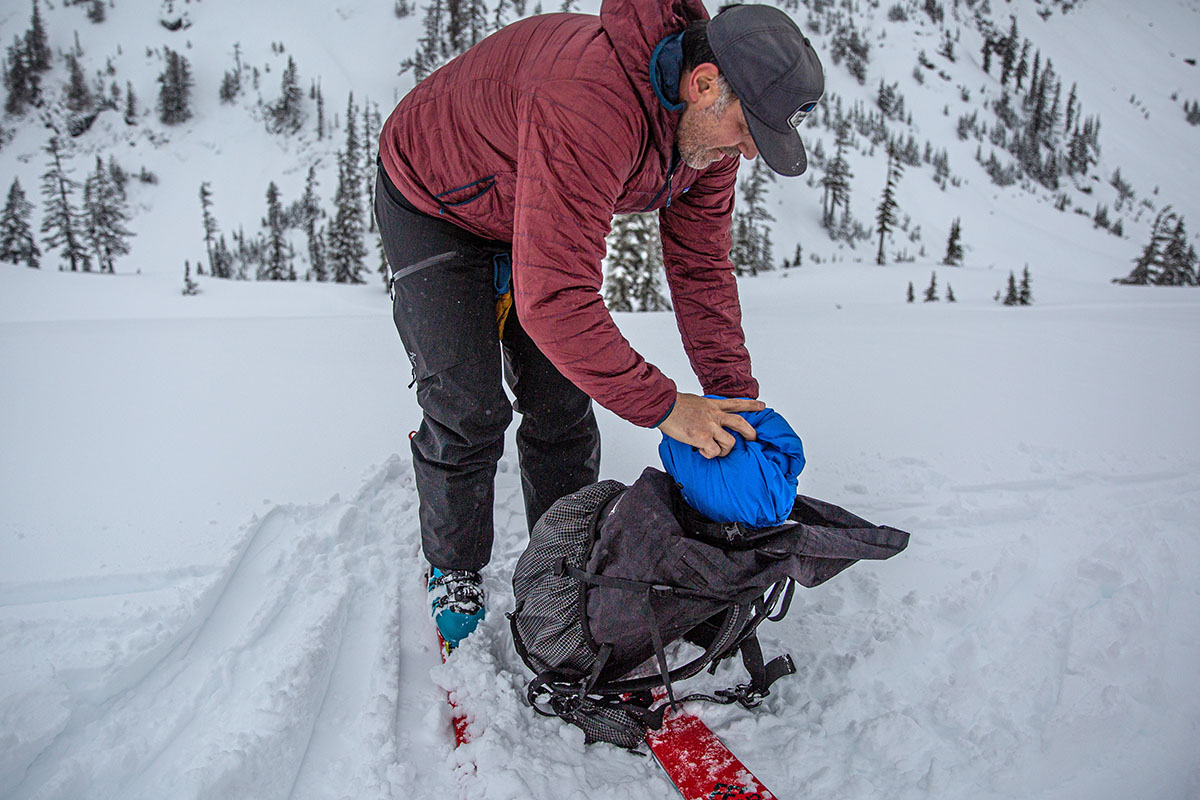
A final—albeit far less technical—option to have on your radar is REI’s Stormhenge Down Hybrid Jacket. Right away, we’ll note that the Stormhenge is far more around-town-friendly than the decidedly technical Beta Insulated, but it’s not totally out of its element outdoors. Like the Arc’teryx, the REI features a 2-layer waterproof shell with fully sealed seams for reliable wet-weather protection, a healthy mix of both down (850-fill) and synthetic (180 and 80g) insulation, a three-way adjustable hood that’s helmet-compatible, pit zips, hook-and-loop cuffs, and even hipbelt-friendly hand pockets. And the Stormhenge manages to pull it off for just $279—almost 1/3 the price of the Beta Insulated. Downsides include a substantial jump in both weight (1 lb. 15.8 oz.) and bulk, plus a noticeably baggier fit. In the end, there’s no question that the Beta Insulated is the better backcountry piece, but the Stormhenge is a nice alternative for more casual outdoor-goers who prioritize value and versatility over all-out performance.
If you’re thinking about buying gear that we’ve reviewed on Switchback Travel, you can help support us in the process. Just click on any of the seller links above, and if you make a purchase, we receive a small percentage of the transaction. The cost of the product is the same to you but this helps us continue to test and write about outdoor gear. Thanks and we appreciate your support!
Depending on the seller, most products ship free in the United States on orders of $50 or more. International shipping availability and rates vary by seller. The pricing information on this page is updated hourly but we are not responsible for inaccuracies.